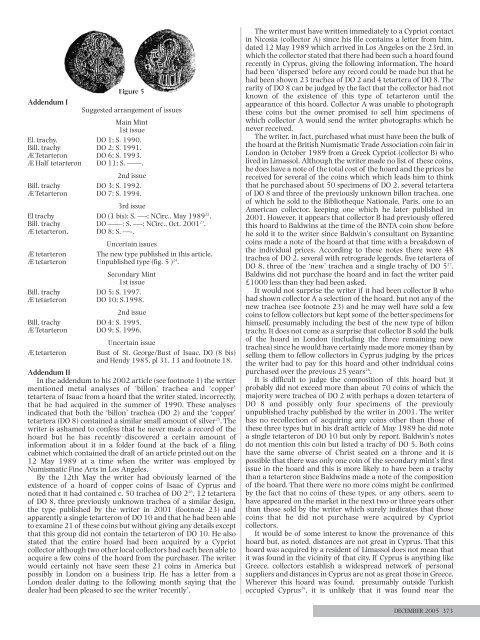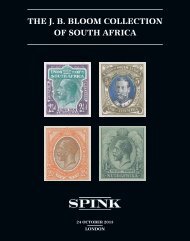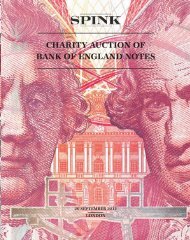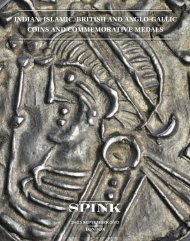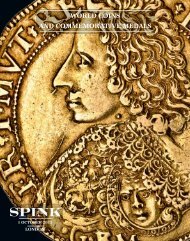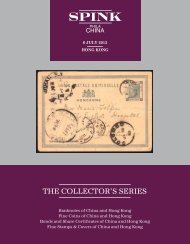Download PDF - Spink
Download PDF - Spink
Download PDF - Spink
- No tags were found...
Create successful ePaper yourself
Turn your PDF publications into a flip-book with our unique Google optimized e-Paper software.
Dec 05 Editorial 29/11/05 4:27 pm Page 373Addendum ISuggested arrangement of issuesMain Mint1st issueEl. trachy. DO 1; S. 1990.Bill. trachy DO 2; S. 1991.Æ Tetarteron DO 6; S. 1993.Æ Half tetarteron DO 11; S. ——.2nd issueBill. trachy DO 3; S. 1992.Æ Tetarteron DO 7; S. 1994.3rd issueEl trachy DO (1 bis); S. —-; NCirc., May 1989 22 .Bill. trachy DO ——; S. —-; NCirc., Oct. 2001 23 .Æ tetarteron. DO 8; S. —-.Uncertain issuesÆ tetarteron The new type published in this article.Æ tetarteron Unpublished type (fig. 5 ) 24 .Secondary Mint1st issueBill. trachy DO 5; S. 1997.Æ tetarteron DO 10; S.1998.2nd issueBill. trachy DO 4; S. 1995.Æ Tetarteron DO 9; S. 1996.Uncertain issueÆ tetarteron Bust of St. George/Bust of Isaac. DO (8 bis)and Hendy 1985, pl 31, 13 and footnote 18.Addendum IIIn the addendum to his 2002 article (see footnote 1) the writermentioned metal analyses of ‘billon’ trachea and ‘copper’tetartera of Isaac from a hoard that the writer stated, incorrectly,that he had acquired in the summer of 1990. These analysesindicated that both the ‘billon’ trachea (DO 2) and the ‘copper’tetartera (DO 8) contained a similar small amount of silver 25 . Thewriter is ashamed to confess that he never made a record of thehoard but he has recently discovered a certain amount ofinformation about it in a folder found at the back of a filingcabinet which contained the draft of an article printed out on the12 May 1989 at a time when the writer was employed byNumismatic Fine Arts in Los Angeles.By the 12th May the writer had obviously learned of theexistence of a hoard of copper coins of Isaac of Cyprus andnoted that it had contained c. 50 trachea of DO 2 26 , 12 tetarteraof DO 8, three previously unknown trachea of a similar design,the type published by the writer in 2001 (footnote 23) andapparently a single tetarteron of DO 10 and that he had been ableto examine 21 of these coins but without giving any details exceptthat this group did not contain the tetarteron of DO 10. He alsostated that the entire hoard had been acquired by a Cypriotcollector although two other local collectors had each been able toacquire a few coins of the hoard from the purchaser. The writerwould certainly not have seen these 21 coins in America butpossibly in London on a business trip. He has a letter from aLondon dealer dating to the following month saying that thedealer had been pleased to see the writer ‘recently’.The writer must have written immediately to a Cypriot contactin Nicosia (collector A) since his file contains a letter from him,dated 12 May 1989 which arrived in Los Angeles on the 23rd, inwhich the collector stated that there had been such a hoard foundrecently in Cyprus, giving the following information. The hoardhad been ‘dispersed’ before any record could be made but that hehad been shown 23 trachea of DO 2 and 4 tetartera of DO 8. Therarity of DO 8 can be judged by the fact that the collector had notknown of the existence of this type of tetarteron until theappearance of this hoard. Collector A was unable to photographthese coins but the owner promised to sell him specimens ofwhich collector A would send the writer photographs which henever received.The writer, in fact, purchased what must have been the bulk ofthe hoard at the British Numismatic Trade Association coin fair inLondon in October 1989 from a Greek Cypriot (collector B) wholived in Limassol. Although the writer made no list of these coins,he does have a note of the total cost of the hoard and the prices hereceived for several of the coins which which leads him to thinkthat he purchased about 50 specimens of DO 2, several tetarteraof DO 8 and three of the previously unknown billon trachea, oneof which he sold to the Bibliotheque Nationale, Paris, one to anAmerican collector, keeping one which he later published in2001. However, it appears that collector B had previously offeredthis hoard to Baldwins at the time of the BNTA coin show beforehe sold it to the writer since Baldwin’s consultant on Byzantinecoins made a note of the hoard at that time with a breakdown ofthe individual prices. According to these notes there were 48trachea of DO 2, several with retrograde legends, five tetartera ofDO 8, three of the ‘new’ trachea and a single trachy of DO 5 27 .Baldwins did not purchase the hoard and in fact the writer paid£1000 less than they had been asked.It would not surprise the writer if it had been collector B whohad shown collector A a selection of the hoard, but not any of thenew trachea (see footnote 23) and he may well have sold a fewcoins to fellow collectors but kept some of the better specimens forhimself, presumably including the best of the new type of billontrachy. It does not come as a surprise that collector B sold the bulkof the hoard in London (including the three remaining newtrachea) since he would have certainly made more money than byselling them to fellow collectors in Cyprus judging by the pricesthe writer had to pay for this hoard and other individual coinspurchased over the previous 25 years 28 .It is difficult to judge the composition of this hoard but itprobably did not exceed more than about 70 coins of which themajority were trachea of DO 2 with perhaps a dozen tetartera ofDO 8 and possibly only four specimens of the previoulyunpublished trachy published by the writer in 2001. The writerhas no recollection of acquiring any coins other than those ofthese three types but in his draft article of May 1989 he did notea single tetarteron of DO 10 but only by report. Baldwin’s notesdo not mention this coin but listed a trachy of DO 5. Both coinshave the same obverse of Christ seated on a throne and it ispossible that there was only one coin of the secondary mint’s firstissue in the hoard and this is more likely to have been a trachythan a tetarteron since Baldwins made a note of the compositionof the hoard. That there were no more coins might be confirmedby the fact that no coins of these types, or any others, seem tohave appeared on the market in the next two or three years otherthan those sold by the writer which surely indicates that thosecoins that he did not purchase were acquired by Cypriotcollectors.It would be of some interest to know the provenance of thishoard but, as noted, distances are not great in Cyprus. That thishoard was acquired by a resident of Limassol does not mean thatit was found in the vicinity of that city. If Cyprus is anything likeGreece, collectors establish a widespread network of personalsuppliers and distances in Cyprus are not as great those in Greece.Wherever this hoard was found, presumably outside Turkishoccupied Cyprus 29 , it is unlikely that it was found near theDECEMBER 2005 373


